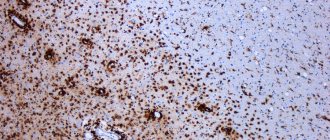One of the manifestations of vegetative-vascular dystonia is sympathoadrenal crisis; the symptoms and treatment of this disease in each case have their own distinctive features. A crisis can occur for various reasons, but the main one is panic. Its appearance is provoked by life situations, strong experiences and psychological trauma.
Among the secondary reasons that can develop the appearance of a crisis are:
- all types of bad habits;
- hormonal disbalance;
- cardiovascular diseases;
- obesity;
- previous neuroinfections;
- diseases of the stomach and intestinal tract;
- psycho-emotional stress;
- hereditary predisposition;
- head injuries.
Sympathetic-adrenaline crisis can develop after suffering severe stress, physical or mental stress. Sometimes the disease can make itself felt in the form of female premenstrual syndrome. A special sign of the development of the disease is the suspension of urine output. This symptom is present throughout the crisis.
Main symptoms of the disease:
- pain in the chest and heart;
- increased blood pressure;
- cardiopalmus;
- headache.
The development of the disease may be accompanied by symptoms such as fever, dry mouth, bulging eyeballs, a sudden attack of fear of death and chills.
The maximum duration of an attack lasts 2 hours, but sometimes the duration of an attack can be shorter, but is more difficult to tolerate. When the next attack occurs, a person may experience severe horror, including the fear of approaching death.
The end of the attack is accompanied by copious urination. This occurs due to increased blood pressure, which affects the functioning of the kidneys. At the end of the crisis, the person feels exhausted and weakened. The headache goes away within an hour, during which time a slight shiver may run through the skin.
To avoid a recurrence of the attack, a person needs to try as much as possible to switch to various positive activities. Otherwise, constant thoughts about the past crisis can trigger the fear of its repetition, which will provoke the onset of a second attack.
Sympathetic-adrenaline crisis is not diagnosed immediately. Sometimes it takes years to confirm it. When diagnosing a disease, a person undergoes a series of examinations. Among them there is a cardiogram and ultrasound of the heart, thyroid gland, and adrenal glands. A brain tomography and spinal cord examination are prescribed. Since a sympatho-adrenal crisis also affects the nervous system, a person must undergo an examination by a neurologist.
This type of examination allows you to clarify the cause of the crisis and increase the body’s defenses. Sometimes it is used to determine a person’s predisposition to this type of disease. If a predisposition is identified, a person is provided with a number of recommendations that can significantly reduce the likelihood of developing the disease.
When confirming the presence of the disease, before starting treatment, the doctor carefully examines the history of the crisis. All reasons that could have contributed to the crisis are considered. The possibility of a hereditary predisposition to this disease and the presence of bad habits are clarified. The doctor takes into account everything, even the patient’s lifestyle. How he eats, what psychological environment is most often present in his home.
If, during all the required types of examination, the patient does not reveal the presence of any pathological processes, then the patient must undergo additional consultation with a psychotherapist.
All treatment begins with establishing the rhythm of life. Normalization of rest, mental and physical activity. All external negative influences that affect the patient’s mental state are eliminated as much as possible. During treatment of the disease, special attention is paid to nutrition. It is necessary to adhere to a strict fortified diet. During the course of treatment, it is strictly forbidden to consume fatty foods and various foods that stimulate the nervous system.
During the treatment of sympatho-adrenal crisis, other types of diseases present in a person are simultaneously eliminated. The patient gets rid of all present bad habits. To speed up the healing process during this period, regular therapeutic exercise and visiting the pool will be useful.
If all these recommendations are strictly followed by the patient, then in such cases drug therapy can be completely excluded by the doctor, since the person will get rid of the disease naturally, having rid himself, first of all, of the root causes that provoke the development of a sympatho-adrenal crisis.
In the event of a relapse of the crisis, the doctor prescribes a comprehensive treatment that combines drug therapy and the elimination of all psychological causes that contribute to an increase in adrenaline in the blood.
Several groups of drugs are used in the treatment of crisis:
- 1. Herbal medicines. These include: St. John's wort, sage, valerian; hawthorn and motherwort can be used for treatment. Having a sedative effect, these herbs can avoid the use of serious drugs in treatment. If treatment with the use of such herbs begins to have a positive effect, then their use may have a very long period. Sometimes treatment with such drugs lasts up to a year.
- 2. Antagonists - this group includes drugs such as Anaprilin, Atenolol and Corvitol. They are usually prescribed for preventive purposes. But they can also be used to eliminate the sympatho-adrenaline crisis that has already occurred.
- 3. Tranquilizers. This group includes drugs such as Adaptol, Phenazepam and Gidazepam. They are usually used for preventive purposes to reduce the likelihood of a recurrent crisis. Their use is limited to a short period of time. The side effects present in them, such as a decrease in mental thinking and causing dependence on the drug, do not allow them to be taken for a longer period.
If we consider non-drug treatment, it consists of finding out the causes of the pathological condition and ways to resolve it. There are several types of techniques. Each of them is used in special cases. The choice of the technique used directly depends on the cause of the disease, the character of the patient and his lifestyle.
If a patient has a serious psycho-emotional imbalance, selective antidepressants can be used; Paxil and Cipralex are usually used.
Sympathoadrenal crisis is one of the manifestations of vegetative-vascular dystonia, characterized by the appearance of characteristic symptoms, mainly increased blood pressure. Sympathetic-adrenal crisis is most often a manifestation of vegetative-vascular dystonia, which is a disease of the autonomic nervous system. However, both external and internal factors may play a role in the causes of these attacks. Internal factors include: adrenal tumors with increased secretion of adrenaline, disturbances in the blood supply to the brain, changes in the content of hormones in the blood.
External provoking factors, first of all, include stressful situations in life, especially chronic stress, leading to an increase in adrenaline levels in the blood. Knowledge of the symptoms and treatment of sympathoadrenal crisis is very important for any person and doctor.
Main manifestations of sympathoadrenal crisis
The most important manifestation of a sympathoadrenal crisis is a sharp increase in blood pressure to high levels. In addition, symptoms of the release of adrenaline into the blood include headache without a specific localization, shortness of breath, trembling throughout the body, even partial convulsions. A number of patients experience pain in the chest associated with a decrease in blood supply to the heart muscle, as well as a rise in body temperature to 38-39 o C.
In addition to the physical manifestations of the disease, symptoms of a sympathoadrenal crisis include changes in a person’s emotional experiences. As a rule, patients experience a strong sense of fear, fear of death, horror, and have a negative attitude towards the people around them.
Symptoms of adrenal crisis last from several minutes to one or two hours, after which they disappear without a trace. However, even a short-term attack leads to great stress and possible negative consequences for the health of the sick person. The attack ends quickly, but for several hours after it, patients note powerlessness and general fatigue.
What can pressure surges during VSD lead to? Manifestations of pathology.
Everything about trigger factors and types of vascular dystonia is here.
Why does a crisis occur?
Sympathoadrenal crisis is caused by various factors. The triggering mechanism is the entry of a portion of adrenaline into the blood due to a malfunction in the sympathetic and parasympathetic nervous system.
The situation can be provoked by:
- Chronic stress and emotional overload;
- Hormonal disorders;
- Bad habits;
- Vitamin deficiency and exhaustion after diets;
- Weakened state after neuroinfection;
- Gastrointestinal diseases;
- Cardiovascular problems;
- Head injuries;
- Overweight and high cholesterol;
- Character traits;
- Bad heredity.
This manifestation often precedes the development of hypertension in young, weak-willed people. Sympathoadrenal crisis occurs in individuals with disorders of the endocrine system from the adrenal glands and pathologies of the brain.
Treatment of the disease
Treatment of sympathoadrenal crises should be comprehensive, including both medications and psychotherapeutic assistance. It is very important to follow a number of preventive recommendations aimed at reducing stress in the patient’s life. A sudden attack of sympathoadrenal crisis requires the initiation of drug treatment, but rarely threatens the patient’s life. As a rule, the most effective sedatives are:
- Various groups of tranquilizers can reduce the level of excitation in the central nervous system and stop the development of a crisis. As a rule, this group of drugs is used for drug prevention of crises.
- Beta blockers, such as Atenolol, Metoprolol, are used to relieve an acute condition and help stop its development at the very beginning. These medications do not allow adrenaline to produce side effects.
Important! The most important place in the treatment of vegetative-vascular dystonia and the prevention of sympatho-adrenal crisis is occupied by psychotherapeutic assistance to patients. Constant psychological interaction with the patient can reduce the intensity of the main symptoms of the disease and reduce the frequency of attacks with increased blood pressure.
Antidepressants are used to prevent sympathoadrenal crises in patients with vegetative-vascular dystonia. However, these drugs have a positive effect several months after long-term and regular use. Effective antidepressants include Fluoxetine, Amitriptyline and others. Treatment of sympathoadrenal crisis is also possible through the use of herbal medicines that can have a mild sedative effect on the human body (infusions of chamomile, motherwort, valerian).
Self-coping techniques
In order to improve your well-being, reduce the frequency of attacks, and also avoid paroxysms of sympathoadrenal crisis, the patient is recommended to carefully work on himself and his condition.
First of all, it is important to understand that there is no real threat to life.
Good results for stabilizing the condition are shown by:
- meditation;
- breathing exercises;
- analytical assessment of your condition.
In addition, one should not forget about preventive measures.
Prevention of sympatho-adrenal crises
The development of a crisis is very easy to prevent; for this, a sick person needs to adhere to a number of simple lifestyle recommendations:
- walk in the fresh air more often, but not at low ambient temperatures;
- improve sleep quality or increase its duration;
- adjust the diet by removing spicy, hot foods from the diet and increasing the consumption of foods enriched with vitamins and minerals;
- fight against bad habits (smoking and alcohol);
- reduction of stressful situations in life.
Find out how VSD manifests itself in children and adolescents. Signs and treatment.
Read here how VSD manifests itself in women.
You can find out the symptoms of a panic attack at this address: https://golmozg.ru/profilaktika/profilaktika-panicheskih-atak.html. How to calm down during a panic attack.
Prevention and treatment of sympathoadrenal crises should be carried out under the supervision of the attending physician, which will prescribe rational treatment and reduce the likelihood of complications for the health of patients.
What happens during a crisis
Let's take a closer look at what happens during the onset of a sympatho-adrenal crisis.
Physical manifestations: a headache occurs, breathing becomes difficult, a feeling of lack of air appears, trembling occurs throughout the body, the sensitivity of the skin may be impaired, even a light touch causes pain, the limbs become cold, the body temperature rises.
In addition, as mentioned above, the heart rate increases and blood pressure rises.
At the time of a sympathoadrenal crisis, the human body experiences an overdose of adrenaline, which is released into the blood in a very significant volume.
Emotional manifestations: the patient develops a feeling of fear, often the person experiences fear of imminent death, unreasonable horror, ceases to trust others and believes that he is in danger.
As a rule, the duration of a crisis does not exceed 1-2 hours, although some patients claim that in fact a panic attack lasts much longer - up to 8 hours. However, even in such a short period, the body is subjected to a colossal test and experiences great stress.
The end of the attack occurs suddenly and is characterized by a feeling of powerlessness and weakness.
The intense work of the kidneys during a crisis results in copious urination, and the urine becomes very light.
After a crisis, it is recommended to remain calm, try to relax or distract yourself with some pleasant activity. This is necessary so that thoughts about the experience do not provoke a second attack.
At the moment, medical practice shows that the treatment of sympathoadrenal crises is quite successful.
Modern techniques and medications, selected by a professional doctor, have a positive effect and help cope with this condition. However, without the desire of the patient himself to overcome the panic state, the specialist will not be able to help fully.
Therefore, only through interaction between the doctor and the patient can the maximum effect be achieved and individual factors that provoke the development of a sympatho-adrenal crisis be overcome.
Tips for when a crisis occurs:
- As soon as the patient begins to notice that a crisis will soon occur, it is necessary to remain completely calm, relax, and, if necessary, ask for support and help.
- If a crisis has already occurred, then you should also remain calm, avoid factors that provoke anxiety, you should try to regulate your breathing, and lie down.
- If the patient is taking medications that soothe and help with this condition, then take the medicine immediately.
- You can go outside and breathe fresh air, which can relieve the condition and relieve headaches and difficulty breathing.
- If it becomes too severe and the condition is not controlled, then you should call an ambulance.
How to deal with panic attacks
Panic attack. What it is? Symptoms of a panic attack.
A panic attack is a condition associated with the sudden release of a huge amount of adrenaline into the blood. Adrenaline is a biologically active substance, it is secreted by the adrenal glands and is a biochemical catalyst for the stress response.
Since a panic attack is a kind of “overdose” of adrenaline, the characteristic symptoms of a panic attack are determined by its action:
- Increased heart rate;
- Feeling of fear;
- Lump in the chest, possible difficulty breathing;
- Violation of thermoregulation (feeling hot or cold);
- Vascular spasm (pallor or marbling of the skin, pulsation in the head, etc.);
- Shiver;
- Large amounts of urine may be leaked.
These symptoms themselves are a source of stress for the patient and can cause a second and third wave of panic attacks. The released adrenaline quickly enters into biochemical reactions and is destroyed, the ability of the adrenal glands to produce adrenaline decreases for a while, after which the panic attack stops. Panic attacks, for all their unpleasant symptoms, can be successfully treated.
Similar symptoms are possible with heart problems, which can be excluded with the help of Holter monitoring, Echo-CG, ECG with stress.
Sympathoadrenal crisis or panic attack?
The condition caused by increased production of adrenaline is also called sympatho-adrenal crisis. There are three main types of sympathoadrenal crises:
- A panic attack is a sympathoadrenal crisis against the background of neurosis with dysfunction of the autonomic nervous system. In this case, the crisis is triggered by the brain (the higher centers of the autonomic nervous system), which gives the adrenal glands an erroneous command to release excess amounts of adrenaline.
- Sympathoadrenal crisis due to adrenal adenoma. In this case, in one of the adrenal glands there is a small benign tumor (adenoma) consisting of cells that produce adrenaline. In response to adequate commands from the brain, the adenoma produces an excess amount of adrenaline, which triggers a sympathoadrenal crisis.
- Vegetative epileptic seizure. In this case, the attack is triggered by a pathological epileptic discharge emanating from the neuron cells of the autonomic nervous system. It is not difficult to establish a connection between a panic attack and epileptic brain activity using an EEG.
The symptoms of panic attacks and sympathoadrenal crises in adenomas are very similar to each other, and their treatment is different. Adrenal adenomas are dangerous and must be removed. In order to confidently differentiate the cause of crises in doubtful cases, in our clinic it is customary to perform ultrasound or tomography of the adrenal glands.
Panic attacks. Causes.
Panic attacks due to neurosis are the most common form of sympathoadrenal crises. The psychological background of panic attacks is psychological traumas and experiences that have not been experienced and repressed into the unconscious. That is why people with high willpower are susceptible to panic attacks, who can force themselves to work “throughout what I can’t”, not cry when experiencing grief, and smile when their hearts are heavy. Emotions that are not fully experienced and not resolved are pushed into the unconscious and stored there for decades. At the same time, nervous stimulation continues to be released to resolve these emotions. And one fine day, even for no apparent reason, the accumulated excitement breaks out in the form of a panic attack.
Panic attacks. Treatment. Medicines.
Medications do not treat the causes of panic attacks, but they can reduce or temporarily eliminate their symptoms. The following groups of drugs are mainly used:
- Beta-blockers (anaprilin, atenolol, etc.). Beta blockers partially block the effect of adrenaline on the body; they can be used to relieve or prevent a panic attack.
- Tranquilizers (phenazepam, alprazolam, etc.). Tranquilizers reduce the excitability of the central nervous system and thus interrupt a panic attack. Tranquilizers can also be used to prevent panic attacks. Tranquilizers quickly relieve the symptoms of panic attacks, but do not treat their causes, which often forces patients to take tranquilizers for years, with resulting drug dependence and decreased ability to think. We prescribe tranquilizers only for the first time, until the causes of panic attacks are eliminated.
- Antidepressants - SSRIs (selective serotonin reuptake inhibitors - Cipralex, Paxil, etc.). As a result of long-term (6-12 months) use of SSRIs, panic attacks usually stop. After stopping SSRIs, a recurrence of panic attacks is possible. To avoid recurrence of panic attacks after stopping medication, we recommend working through the psychological component of panic attacks with a professional psychotherapist.
Panic attacks. Treatment. Psychotherapy.
Psychotherapy is the only way to get rid of panic attacks once and for all. Moreover, in contrast to popular belief, a psychotherapist will not “talk and calm you down,” but, on the contrary, through energetic psychotherapeutic work together with you, he will lure you out of the depths of the unconscious and resolve the cause of panic attacks. We use several psychotherapy techniques to treat panic attacks. Taking into account the patient’s condition and wishes, therapy is proposed that brings the fastest and most complete results. After 1-2 months of therapy, our patients usually feel absolutely normal.
Panic attacks. Treatment. Routine, nutrition, physical activity.
Regime, nutrition and physical activity during panic attacks do not significantly affect the causes of the disease. But following these recommendations will help you soften the course and reduce the frequency of panic attacks:
- Get as much sleep as possible;
- Eat food 3-4 times a day, preferably at the same time;
- Take walks in nature;
- Load yourself with physical exercise;
- Reduce your intake of stimulants (coffee, large doses of B vitamins, energy drinks, alcohol);
- Avoid watching programs and films with scenes of violence.
Adrenal, Addisonian crisis or acute insufficiency of the adrenal cortex is an extreme and severe manifestation of Addison's disease. Accompanied by a decrease in the functional activity of the adrenal cortex. Such crises are very difficult, occur against a background of severe physical or emotional stress and often lead to death.
The main reason for the formation of an adrenal crisis is a sharp cessation of the work of the adrenal cortex, a sharp decrease in the level of adrenal hormones in the blood. This usually occurs in the following cases:
- when canceling hormonal replacement drugs in patients suffering from Addison's disease,
- in case of injury to the adrenal gland or surgery,
- in acute generalized infections and sepsis with necrosis of the adrenal cortex,
- with hemorrhages in the adrenal cortex,
- with severe blood loss or burn disease.
As a result of all these reasons, there is a critical decrease in the amount of hormones produced by the adrenal cortex. The result is fluid loss and dehydration with a simultaneous loss of potassium, disruption of the heart muscle and other muscles of the body. Carbohydrate metabolism suffers, which leads to kidney failure. In a short time, a person can fall into a coma.
First aid for an attack
According to research in the field of psychotherapy, almost 2.5% of all people on the planet suffer from panic disorder. And in highly developed countries, for example, in America, more than 50% of patients undergo annual treatment with a psychotherapist [19]. Panic attacks are often combined with agoraphobia (fear of being in public places). In this case, the cause of agoraphobia is considered to be a panic attack.
| Distribution for 1 year, % | Ratio by gender (women to men) | Age at onset of illness (years) | Spread to immediate family | |
| Panic attacks | 2,3 | 5:2 | 15-35 | High |
Among psychotherapists, the following theories of the development of panic disorder are most popular:
- Biological theory.
- Cognitive.
It began to take shape in the 60s of the last century. When it was discovered that patients suffering from this disease are helped not by strong sleeping pills (benzodiazepines), but by drugs used to eliminate the symptoms of depressive disorder (antidepressants).
Based on the knowledge that antidepressants cause changes in the activity of norepinephrine and serotonin (mediators that facilitate the transmission of signals between neurons in the brain), it was assumed that panic crises could be caused by the abnormal activity of these substances.
It was possible to prove that patients have inconsistent activity of this mediator. An experiment was conducted in which monkeys were electrically stimulated in the locus coeruleus (an area of the brain involved in the regulation of emotions, containing a large number of neurons that use norepinephrine) [67]. At the same time, they recorded reactions that were very reminiscent of panic.
Another experiment was conducted in which a patient was induced to panic by injecting him with a substance that affected the activity of norepinephrine.
Her flaws
However, it was not possible to determine what the real cause of the pathology was. What kind of activity contributes to this: increased or decreased, or is it another type of disturbance associated with norepinephrine. In addition, it was possible to determine that it is not the only mediator involved in the development of the disease.
It has not been possible to determine why people are susceptible to this biological anomaly. An option with a genetic predisposition was considered. But then, the susceptibility to attacks should increase with the degree of relatedness. But research results do not show such a clear trend [35].
The results of treatment with antidepressants show improvement in 80% of cases, 40% of patients experience significant improvement or complete recovery. In this case, the improvement lasts up to 4 years or more. But, in many situations, the use of medications alone is not enough [11]. The most effective is its simultaneous combination with the help of a qualified psychotherapist.
It appeared not very long ago and has already become popular. It is based on the assertion that people susceptible to the psychological anomaly in question are highly sensitive to certain sensations in their body (tight breathing, intense anger, excitement) and they misperceive them, interpreting them as signs of a disease.
- Poorly developed ability to deal with stress.
- Lack of social support.
- Possible psychological problems in childhood (lack of control, inadequate reaction of parents to the child’s psychological problems).
- Hereditary chronic diseases.
In accordance with the cognitive theory, people with an increased level of anxiety sensitivity, which is determined by a doctor conducting special (biological) tests, are more susceptible to vegetative-vascular crises. This is a special procedure used to induce a panic attack in patients by fulfilling certain requirements, directly under the supervision of a psychotherapist.
It has been scientifically proven that cognitive therapy is significantly more effective than drug treatment for the treatment of panic attacks. Although many practitioners have tried to combine the two, it is not yet well understood whether this is more effective than cognitive therapy alone [68].
A panic attack always develops rapidly. Most often, assistance to a patient in this condition is not required. In almost all cases, the patient is able to independently deal with his problem and control himself.
Excessive worry can only provoke and intensify negative feelings. The environment should behave in such a way as not to aggravate the patient's condition.
When an adrenaline crisis begins, it is recommended to open the windows and unfasten too tight clothes. You can offer to drink light sedatives - such as Corvalol, Validol.
It would be a good idea to measure your blood pressure. If necessary, medications to help with hypertension should be given. If relief does not occur within half an hour, medical attention is required. It is recommended to call emergency assistance.
Symptoms of adrenal crisis
An adrenal crisis can develop over several hours, less often over several days. Initially, muscle pain and severe weakness appear, and appetite is impaired. Signs of an upcoming crisis are:
- a sharp decrease in pressure,
- arrhythmia, feeling of interruptions in the work of the heart,
- heavy sweating,
- cold extremities, chills,
- severe weakness with inability to stand,
- diarrhea, nausea and vomiting,
- sharp and severe pain in the abdomen,
- a sharp decrease in the amount of urine,
- difficulty speaking, fainting, hallucinations,
- development of coma.
When such symptoms appear, urgent hospitalization in the intensive care unit with the introduction of a whole range of drugs is necessary.
Diagnostics
In case of adrenal crisis, a blood test is urgently performed, which will show a sharp leukocytosis and acceleration of ESR, a sharp increase in the level of red blood cells. At the same time, the blood glucose level is sharply below normal. The amount of electrolytes - sodium, potassium and chlorine - decreases sharply, and creatinine decreases. A urine test reveals acetone, protein and red blood cells.
A blood test for hormone levels will reveal a sharp decrease in the level of adrenal hormones - corticosteroids. An ECG reveals cardiac conduction disturbances.
Treatment of adrenal crisis
Treatment of adrenal crisis is carried out in the intensive care unit - corticosteroid therapy is carried out with individual dose selection, as well as drip infusion of electrolyte solutions and glucose. Antishock therapy is carried out.
- Urgent hospitalization is indicated.
- 0.9% sodium chloride solution is administered intravenously until dehydration is eliminated, hydrocortisone. Clinical improvement (assessed primarily by blood pressure recovery) usually occurs 4 to 6 hours after intravenous therapy.
- If the temperature rises (against the background of normal blood pressure), antipyretic drugs, such as paracetamol, are prescribed.
- During surgical interventions, it is necessary to adjust the dose of steroid hormones.
- Prevention of infectious diseases.
Usually, after an adrenal crisis, you have to be on hormone replacement therapy for life, since the adrenal glands can no longer function as before, they are irreversibly damaged.
The patient will be registered with an endocrinologist for life, and drug doses will be constantly adjusted.
Content:
A sympatho-adrenal crisis sounds strange and unfamiliar to many. In fact, some people know very well what we are talking about. This condition has a more familiar name: panic attack. And if you experience it once, you will never confuse it with any other condition again. Sympatho-adrenal crisis is characterized by many neurological symptoms. But the most dangerous and distinctive of them is a wild, deadly, almost animal horror. A panic attack can occur suddenly, but the result is always the same: a person loses touch with reality and is suffocated by the fear of death.
A crisis is not a separate disease, it is only signs of a mental disorder, the sympathetic system. But the problem is that such a disorder can be fatal for a weakened person. It is impossible to explain to a person unfamiliar with this condition how difficult it is to bear and where it comes from. For most, any somatic disorder is a whim, an invention, a desire to attract attention to oneself. Especially if the child has symptoms of sympatho-adrenal crisis.
Meanwhile, the crisis begins with the development of a panic attack. The answer is a sharp jump in pressure, which can have serious consequences if the cardiovascular system is weak. A headache begins, severe and debilitating. An ice lump forms inside, as if a person had swallowed a piece of ice. Sometimes patients describe it as an air pocket inside. It grows, absorbing the patient's ability to think adequately. Against the background of these signs, others appear:
- pulse becomes rapid;
- sweat pours down your back;
- blood pulsates in the veins, in the head;
- there is a feeling that you forget to breathe.
This makes the breaths become deeper and more frequent, but after a while it is no longer possible to take a breath. The blood is too saturated with oxygen. But the person is afraid of suffocating and gasps for air, despite the pain in the ribs from frequent contractions of the diaphragm.
A sympatho-adrenal crisis can have three stages, the duration of the attack depends on this. In a mild form, the symptoms disappear within a few minutes, in a complicated form they disappear in an hour or two. In a severe stage, an attack can last up to a day. Recovery from it takes time. The first sign that the crisis has subsided is excessive urination.
But even in this case, the patient must understand: he will not die from his condition if he learns to control himself and work with his fear. It is difficult, it takes time and practice, but success will allow you to return to life.
Causes of sympatho-adrenal crisis
This condition has one cause - a disorder of the autonomic nervous system. Losing stress resistance, the nerves cease to respond adequately to external stimuli. Part of the autonomic system is the sympathetic one. It is given by nature to strengthen the integrity of the central nervous system and protect against stress. It is in close connection with the adrenal glands, which produce adrenaline. Adrenaline can be positive and negative, but sometimes even the negative system can be made to work for the good. Surely someone has noticed that under the influence of severe stress, he can feel ideal for some time and is characterized by increased performance.
But the fact is that this is an analogue of anesthesia caused by adrenaline. Otherwise, the body simply cannot survive most stress:
- pain shock;
- heavy blood loss;
- hormone releases;
- restructuring of the body under the influence of a third factor.
There is a second factor that can almost out of the blue cause symptoms of a sympatho-adrenal crisis - this is the spine. The fibers of the system are extremely delicate and sensitive and they pass through the spinal column. Even a slight pinching of the process will cause a severe aggravation. Therefore, spinal health is extremely important for such patients.
conclusions
Sympathoadrenal crisis is a pathology that occurs against the background of vegetative-vascular dystonia. Characterized by fear of death.
Most often, the pathology develops due to disruption of the autonomic nervous system, but disturbances of a psycho-emotional nature are also possible.
A sympathoadrenal crisis in itself does not threaten the patient’s life, but can provoke suicidal thoughts.
To avoid a paroxysm of pathology, you should work hard on yourself, change your lifestyle, and give up bad habits. In particularly severe sympathoadrenal cases, drug therapy or the help of a psychotherapist may be required.
How to help a patient win
The causes of sympatho-adrenal crises are difficult to eliminate. Although the specialist will give the necessary recommendations:
- do not be nervous;
- protect the body from stress;
- strengthen the vascular system.
But today it is impossible to accomplish this, the speed of life and its difficulties cause stress every day. There is no algorithm for stopping panic attacks; from time to time, exacerbation will occur. In the first stages, when the attacks are minor, you can get by with supportive therapy:
- Corvalol, Valocordin;
- tinctures of mint, thyme, lemon balm;
- glycine tablets.
It is important to learn to work with yourself, to try to calm the growing panic. A suggestion like this would be suitable: this is not fatal, it’s just an attack, now it will pass and everything will stabilize. If there are already signs of oxygen oversaturation from frequent breathing, take the bag and slowly breathe into it. After a few minutes of breathing control, it is usually possible to restore normal breathing and get rid of convulsive breaths. The attack will begin to decrease, sometimes this is enough to stabilize blood pressure.
If the attack is severe, treatment of symptoms of sympathoadrenal crisis includes:
But these are powerful drugs and can be purchased strictly according to prescriptions. Used only for severe symptoms. For example, with the development of seizures, convulsions. A neuropsychiatrist can prescribe antidepressants, most often Rexitin (Paraxin). The drug is cumulative and is always taken for a long time. The dosage is only individual; with correct treatment, attacks can be stopped quickly and a lasting remission can be achieved for years.
Symptoms of sympathoadrenal crisis are frightening and often devastating. It is important not to leave the patient alone, to work towards a positive instillation of a successful outcome. This condition is especially dangerous for hypochondriacs, melancholic people and those who are normally inclined to harm themselves.
Sympathetic-adrenal crisis is one of the manifestations of vegetative-vascular (neurocirculatory) dystonia, its hypertensive type. It is characterized by symptoms of activation of the sympathetic part of the autonomic nervous system. Because of this, in the USA and Europe it is replaced by the term “panic attack”. Our scientists consider attacks activated by the central nervous system to be just a separate version of a crisis.
The sympathetic system regulates the functioning of organs in extreme situations, influencing their receptors with the help of adrenaline and norepinephrine. Normally, it works in close connection with the parasympathetic part of the autonomic system, which ensures inhibition of work “at maximum.” When the influence of the parasympathetic system weakens, or when the sympathetic part becomes overactive, a sympatho-adrenal crisis occurs. This can happen due to a number of reasons.
Prevention of complications
Of course, an adrenal crisis does not go unnoticed for people. Especially in the absence of timely treatment for those diseases that became its root cause. After the attack ends, the person is recommended to make an appointment with a specialist and undergo examination followed by treatment.
Complications of adrenal crisis:
- hemorrhage in the brain structures;
- severe encephalopathy;
- unstable form of angina - with frequent arrhythmias;
- swelling of lung tissue;
- acute cardiac failure.
Experts include all healthy lifestyle measures as primary measures to prevent adrenal crisis, as well as its complications:
- a full night's rest - in a well-ventilated area, at least 8-10 hours;
- daily long walks;
- proper nutrition - dishes with minerals and vitamins for the nervous system;
- refusal of alcohol, tobacco products, as well as synthetic energy drinks;
- minimize negative information - from the TV screen, computer, it is better to replace them by watching your favorite comedies, reading books;
- reduce stress levels - do not quarrel with colleagues and relatives.
The health of every person is in his hands. Since an adrenal crisis is only a symptom of a malfunction in the sympathetic system, it is completely preventable.
Source: nerv-info.ru
Why does this symptom complex develop?
The fact that this is not a disease, but a combination of symptoms, is indicated by its short duration (up to 2 hours), the variety of symptoms in the same person with each new attack, and the possibility of the existence of several causes that can provoke the same manifestations.
The main causes of sympatho-adrenal crisis are as follows:
- A psycho-emotional state that arose as a result of some external events and reasons. In this case, the brain gives the command to release an increased amount of adrenaline (even if unconsciously for the patient). Such crises can be called panic attacks.
- A tumor of the adrenal medulla of any degree of malignancy, which is capable of releasing increased amounts of catecholamines into the blood from time to time (the so-called norepinephrine and adrenaline). This process does not depend on the brain, and no matter how calm a person’s life might be called, crises will still occur periodically.
- Tumor of the spine or spinal cord, ischemia, or other cause of increased stimulation of the central sympathetic system cells found in the spinal cord.
- Pathological impulses of areas of the cerebral cortex, which are associated with the hypothalamus and the sympathetic nervous system, are a kind of epileptic attack, which is manifested precisely by the symptoms of a sympatho-adrenal crisis.
Although the causes of sympatho-adrenal crisis are quite diverse, the main one is considered to be a panic attack. Such attacks initially occur not by a person’s will, but as a result of experiences and psychological traumas repressed into the subconscious. Those who suffer from such attacks are more obliging people who take everything very seriously and can force themselves to do something that they absolutely do not want to do. After the first attack appears, its relapses may be associated not with the fact that the person continues to live under conditions of increased stress, but with the fear of experiencing such symptoms again.
Other perivascular crises
CSF crisis, hemolytic crisis, vagoinsular crisis, and vegetative-vascular paroxysm have similar symptoms.
However, the causes of all these attacks are different, therefore treatment is selected individually in each case.
That is why, if alarming symptoms appear, you should consult a doctor who, after conducting diagnostic measures, will be able to accurately determine the type of crisis and prescribe the necessary course of treatment.
How does the symptom complex manifest itself?
Typically, the symptoms of a sympatho-adrenal crisis develop after a person has experienced some kind of severe stress, he has been very physically tired, or (in women) the crisis has developed against the background of premenstrual syndrome.
The crisis develops acutely, suddenly. More often this happens at night or in the afternoon. Various symptoms of sympathoadrenal crisis appear, the main ones are the following:
- Horror, fear of death;
- A feeling of “compression” of the chest, in which a person does not have enough air;
- Headache;
- Increased blood pressure (its “upper” systolic component can be even 200-230 mm Hg);
- Chills throughout the body;
- The heartbeat increases significantly, arrhythmias may appear, felt as interruptions in the heart;
- Coldness of the extremities;
- Dry mouth;
- Sometimes body temperature rises;
- There may be pain in the chest or around the heart.
After the end of the crisis, a person feels exhausted and exhausted. He produces a large volume of light-colored urine, and for some time continues to have a headache and mild tremors. If you do not switch at this moment to something pleasant that brings psycho-emotional comfort, then after a while the next attack may follow, associated with the fear of experiencing similar sensations again.
Pathology therapy
Initially, basic therapy is prescribed, during which the person must undergo additional studies to exclude the organic nature of such conditions. Simply put, it is necessary to find out whether pathology of the adrenal glands, spinal cord and brain caused the development of the crisis. Treatment will depend on this.
Treatment of sympatho-adrenal crisis (panic attack) consists of two components: drug correction and psychotherapy. In addition, the doctor gives recommendations on nutrition and lifestyle, which is important in order to cope with such conditions.
Drug therapy
The following groups of drugs are used to treat a crisis:
- Beta-adrenergic receptor antagonists: Anaprilin, Atenolol, Corvitol. These drugs can be used in the absence of contraindications (chronic bronchitis, bronchial asthma) both for the treatment and prevention of a crisis.
- Tranquilizers: Gidazepam, Adaptol, Phenazepam. It is advisable to take them only for the first time, until the effect of psychotherapy appears or at the time of undergoing an examination regarding the causes of the crisis - their long-term use reduces the ability to think and causes psychological dependence. The drugs can be used both for relief and for the prevention of crisis. They are quite effective, but do not treat the cause.
- Selective antidepressants: Cipralex, Paxil. These medications are prescribed for a long period of time; their withdrawal is possible only if there is an effect from psychotherapy.











